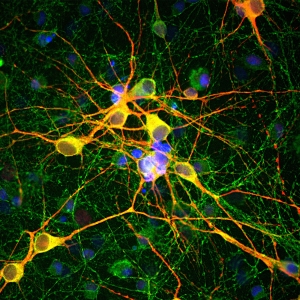We have research proven antibodies with uses across a wide variety of research areas. Our PGP 9.5 antibody (Cat.# GP14104) exemplifies this, being used in two studies that were published this past week highlighting the many fields in which our antibodies are applicable. Find all customer publications using our PGP 9.5 antibodies here.
The first study looked at how the immune system and neural system interact to cause abdominal pain. Specifically, they found that enteric glia play a role in connecting the two by disrupting the glial-mediated activation of macrophages. This suggests that enteric glia could be a focus of potential therapies of abdominal pain.
Top Image: Images showing immunolabeling in colon samples for M-CSF in human myenteric ganglia from individuals with Crohn disease along with control colon samples from patients that underwent resections for bowel trauma, volvulus, or intestinal bleeding.
Learn more...

In the second study, researcher explore the male-biased rate of cases of Hirschsprung disease (HSCR). HSCR is a life-threatening genetic disorder that results in the incomplete formation of the enteric nervous system (ENS). Using the TashT mutant mouse line, which displays a robust male bias, they find that malformation of the ENS involves upregulation of the Y-linked gene, Ddx3y. They find that Ddx3y is upregulated due to increased transactivity of p53. The Ddx3y gene is different from the HSCR candidate gene proposed in humans, but the DDX3Y protein has also been found in human HSCR patients. Overall, the Ddx3y gene may in fact play a role in HSCR in humans.
Bottom image: The DDX3Y protein is present in enteric neurons from the intermediate zone in a subset of HSCR patients.
Citations:
- Vladimir Grubisic, Jonathon L. McClain, David E. Fried, Iveta Grants, Pradeep Rajasekhar, Eva Csizmadia, Olujimi A. Ajijola, Ralph E.Watson, Daniel P .Poole, Simon C. Robson, Fievos L. Christofi, and Brian D.Gulbransen. (2020). Enteric Glia Modulate Macrophage Phenotype and Visceral Sensitivity following Inflammation.Cell Reports, 32(10), 108100. doi: 10.1016/j.celrep.2020.108100
- Tatiana Cardinal, Karl-Frederik Bergeron, Rodolphe Soret, Ouliana Souchkova, Christophe Faure, Amelina Guillon, and Nicolas Pilon. (2020). Male-Biased Aganglionic Megacolon in the TashT Mouse Model of Hirschsprung Disease Involves Upregulation of p53 Protein Activity and Ddx3y Gene Expression.PLoS Genetics, 16(9): e1009008. doi: 10.1371/journal.pgen.1009008







